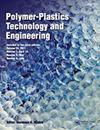Influence of Single-Walled Carbon Nanotubes on the Performance of Poly(Azomethine-Ether) Composite Materials
Q2 Materials Science
引用次数: 11
Abstract
ABSTRACT The present work is aimed to fabricate a new set of composite materials containing conducting poly(azomethine-ether) reinforced with single-walled carbon nanotubes in the form of single-walled carbon nanotube/poly(azomethine-ether)1–5 for excellent enhanced thermal as well as conducting behavior of poly(azomethine-ether). Single-walled carbon nanotubes of variable loading have been embedded into conducting poly(azomethine-ether) using in situ polymerization technique. Before attempting the polymerization, 1,3-thiazole established poly(azomethine-ether) and its conformable monomers have been prepared and their chemical structures have been correlated by spectral analyses. Furthermore, ηinh and Mw values for poly(azomethine-ether) were found 0.89 dL g−1 and 39723.6, respectively. The fabricated single-walled carbon nanotube/poly(azomethine-ether)1–5 composites were specified and characterized by wide-angle X-ray diffraction patterns, Fourier transform infrared spectroscopy, thermal behavior, scanning electron microscopy, and transmission electron microscopy characterization techniques. A perfect indicative response for this composite material was estimated by Fourier transform infrared spectra and X-ray diffraction as well. Both techniques displayed all intensive characteristic peaks regarding single-walled carbon nanotubes and poly(azomethine-ether) in the spectra or diffraction pattern for single-walled carbon nanotube/poly(azomethine-ether)1–5. The role of single-walled carbon nanotubes on the performance of poly(azomethine-ether) was considerably examined. Single-walled carbon nanotube/poly(azomethine-ether)1–5 showed relatively higher thermal stability. Single-walled carbon nanotube/poly(azomethine-ether)1 displayed the lowest final composite degradation temperature value (552°C), whereas single-walled carbon nanotube/poly(azomethine-ether)5 displayed the highest value (621°C). T10 and T25 values showed a gradual temperature increased while single-walled carbon nanotubes increased. Single-walled carbon nanotube/poly(azomethine-ether)1 showed the lowest thermal stability and single-walled carbon nanotube/poly(azomethine-ether)5 showed the highest thermal stability between all fabricated products. Furthermore, transmission electron microscopy images showed a prominent increase in single-walled carbon nanotubes diameters (40–60 nm). The conductivity values were significantly increased while single-walled carbon nanotubes content was increased and reached to the semiconductors. ε′ values were also increased in both single-walled carbon nanotube/poly(azomethine-ether)4,5 which have higher single-walled carbon nanotubes content. GRAPHICAL ABSTRACT单壁碳纳米管对聚偶氮醚复合材料性能的影响
摘要:本研究旨在制备一种新型的以单壁碳纳米管/聚偶氮醚1-5形式增强导电聚偶氮醚的复合材料,以提高聚偶氮醚的导热性能和导电性能。采用原位聚合技术将负载可变的单壁碳纳米管嵌入导电聚偶氮甲醚中。在尝试聚合之前,已经制备了1,3-噻唑建立的聚偶氮甲醚及其构象单体,并通过光谱分析对它们的化学结构进行了关联。聚偶氮醚的ηinh和Mw值分别为0.89 dL g−1和39723.6。采用广角x射线衍射图、傅里叶变换红外光谱、热行为、扫描电镜和透射电镜等表征技术对制备的单壁碳纳米管/聚偶氮醚1-5复合材料进行了表征和表征。用傅里叶变换红外光谱和x射线衍射估计了该复合材料的完美指示响应。在单壁碳纳米管/聚偶氮醚的光谱或衍射图1-5中,两种技术都显示了单壁碳纳米管和聚偶氮醚的所有密集特征峰。研究了单壁碳纳米管对聚偶氮醚性能的影响。单壁碳纳米管/聚偶氮醚1-5具有较高的热稳定性。单壁碳纳米管/聚偶氮醚复合材料的最终降解温度最低(552℃),单壁碳纳米管/聚偶氮醚复合材料的最终降解温度最高(621℃)。随着单壁碳纳米管的增加,T10和T25值逐渐升高。单壁碳纳米管/聚偶氮醚热稳定性最低,单壁碳纳米管/聚偶氮醚热稳定性最高。此外,透射电镜图像显示单壁碳纳米管直径(40-60 nm)显著增加。随着单壁碳纳米管含量的增加,其电导率显著提高。单壁碳纳米管/聚偶氮醚的ε值也增加了,而单壁碳纳米管的含量较高。图形抽象
本文章由计算机程序翻译,如有差异,请以英文原文为准。
求助全文
约1分钟内获得全文
求助全文
来源期刊

Polymer-Plastics Technology and Engineering
工程技术-高分子科学
CiteScore
1.71
自引率
0.00%
发文量
0
审稿时长
4 months
 求助内容:
求助内容: 应助结果提醒方式:
应助结果提醒方式:


